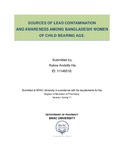| dc.contributor.advisor | Neelotpol, Dr. Sharmind | |
| dc.contributor.author | Hia, Raksa Andalib | |
| dc.date.accessioned | 2015-05-27T06:34:02Z | |
| dc.date.available | 2015-05-27T06:34:02Z | |
| dc.date.copyright | 2015 | |
| dc.date.issued | 2015-03 | |
| dc.identifier.other | ID 11146010 | |
| dc.identifier.uri | http://hdl.handle.net/10361/4165 | |
| dc.description | This project report is submitted in a partial fulfillment of the requirements for the degree of Bachelor of Pharmacy, 2015. | en_US |
| dc.description | Cataloged from PDF version of Internship report. | |
| dc.description | Includes bibliographical references (page 58-64). | |
| dc.description.abstract | Lead is one of the oldest toxins existing in the environment because of its nature and extensive
use from the ancient times. Lead is commonly known as a silent killer because, at any
concentration, without any noticeable symptom it can affect almost all organs in the
body.Unsafe blood lead levels may cause lower IQ level, autism, abnormal delivery and may
increase the involvement in crime. Generally, pregnant women, fetus and children are the most
vulnerable groups to lead poisoning because of rapid bone mobilization and neurodevelopment.
Therefore, the aim of this study was to evaluate the awareness about lead among Bangladeshi
women of child bearing age. To evaluate the knowledge on exposure to lead, a questionnaire
survey was conducted and completed by all participants (Less-educated women, n=62;
Educated women, n=52). Data were analyzed by using SPSS (Version20). Appropriate
statistical tools were utilized to draw the results. The study findings showed that there is a highly
significant difference in economic condition (p<0.0001), home location (p<0.0001), cosmetics
use (p<0.0001), even in food habit (p<0.0001) between the groups. Moreover, significant
difference has also been found in awareness about lead toxicity among educated and lesseducated
women (p<0.0001). However, interestingly, no significant difference was found in the
knowledge about the (hidden) sources of lead in everyday life between the groups (p<0.109),
frequency of lipstick use (p<0.201) and in the use of coloring agents in food (p<0.724). Since
lead exposure reduces the IQ level at any concentration, therefore, scientists have found an
economic impact of lead on the society. The importance of this study lies in the fact that, if the
women are aware about the sources of lead and consequences of lead toxicity, the body lead
burden could be reduced in the next generation as lead can directly affect the fetus from
mothers’ exposure. | en_US |
| dc.description.statementofresponsibility | Raksa Andalib Hia | |
| dc.format.extent | 71 pages | |
| dc.language.iso | en | en_US |
| dc.publisher | BRAC University | en_US |
| dc.rights | BRAC University project report are protected by copyright. They may be viewed from this source for any purpose, but reproduction or distribution in any format is prohibited without written permission. | |
| dc.subject | Pharmacy | en_US |
| dc.title | Sources of lead contamination and awareness among Bangladeshi women of child bearing age | en_US |
| dc.type | Project report | |
| dc.contributor.department | Department of Pharmacy, BRAC University | |
| dc.description.degree | B. Pharmacy | |

